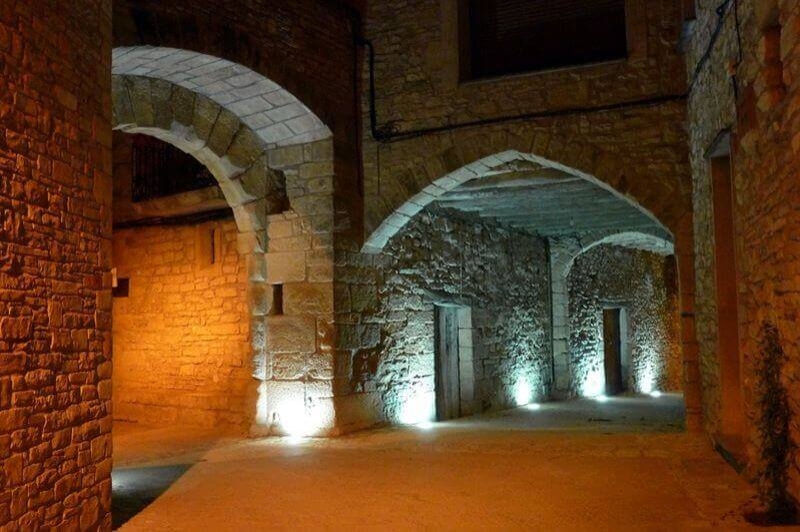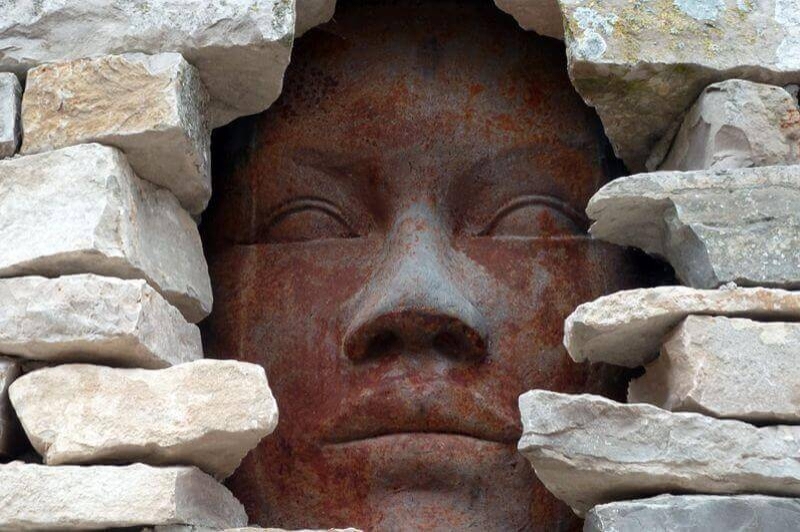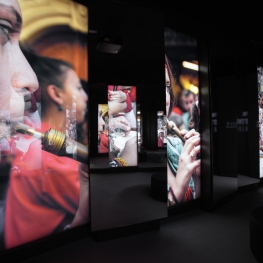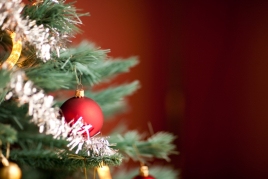Conesa
The municipality of Conesa is located entirely on the Segarrenco plateau of the Conca de Barberà and includes the depopulated villages of Sabella, Torlanda and Saladern.
The old town was declared a Cultural Asset of National Interest (BCIN) by the Generalitat of Catalonia in 2011. On December 8, 1043, Ramon Berenguer I granted it a charter of settlement, and the castle of Conesa is mentioned in his will of 1076. James I granted it the status of a town in 1260 and authorized a weekly market. In 1390, John I authorized a Jewish quarter of 10 houses, located on Ravalla Street.
The Monastery of Santes Creus held jurisdiction for 550 years, from 1285 to 1835, when, with the Mendizábal confiscations, the monks left these lands. Abbot Jerónimo Contijoch rebuilt the Delmera house on the site of the new castle or manor house of the Montpaó family. In the 14th century, the village reached its peak population of 650 inhabitants, and today just under one hundred remain.
Conesa is situated between two streams that carry water to the Corb Valley, with forests of pine, oak (called rebollos), beech, and maple trees. Today, only cereals (wheat and barley) are cultivated, although years ago there were vineyards, hazelnut groves, flax, and saffron.
The village has an almond-shaped layout, enclosed by a wall formed by the houses themselves at the rear. The facades face the interior streets, which run almost parallel to the wall.
Its narrow, steep streets fully preserve the medieval atmosphere of the era in which they were built. Today, old, well-worked stones, modernist tiles, and striking sculptures are scattered throughout the village.
In the surrounding area, you can enjoy beautiful excursions through forests and fields that change color with the seasons. 42km of well-marked trails will allow you to explore different corners of the region.
What to visit
The medieval village of Conesa is defined by an enclosure, perfectly delimited by a defensive wall. The only openings are two gates that facilitated control by the lord. The urban structure is an example of a circular model, following the contour lines, with the castle in the highest area.
The church is situated at an angle, its bell tower serving as a defensive feature, a typical element of northern Italy and Catalonia. The city wall is doubly reinforced by the presence of two streams that largely surround it. The Town Hall was built on Calle Mayor, which connected both gates.
The street layout comprises a single street, running from behind the castle to the town square, although it has been known by different names over the centuries: Ravalla, de Dalt, de la Font, and Major. There are three cross streets and three dead ends.
The slope means that in some alleyways we find stairs, and with the use of the land we can easily imagine Medieval Conesa.
A conesa la belleza
Conesa, like many towns and villages, has a nickname, "la vejez" (old age), although the people of Conesa accept both variants: "la vejez" (old age) and "la belleza" (beauty). We usually spell this adjective with a "b" to emphasize its attractiveness, as it appears in the "Romancer" of Milán and Fontanals.
"From Conesa, beauty;
Segura's measure;
of Savalla, the quartan half;
hooligans in Guimerà."
("Romancer" - Milan and Fontalals)
However, the people of Cones also accept the nickname "old age" because of their history and antiquity, already referenced from the beginnings of Catalonia, and of which the findings of fossils, Iberian tombs, Roman clay, Gothic and Arabic toponyms that speak of many centuries of population are a good example.
Places of interest
Portal of Santa María
The Portal de Santa Maria is one of the most emblematic entrances to the walled town of Conesa. It retains its original medieval structure, with perfectly defined stone arches. Passing through it is like stepping into a town that has managed to keep its essence intact throughout the centuries.
Plaça Major
The Plaça Major is the heart of Conesa's social and cultural life. Surrounded by stone houses and porches, it retains all the charm of the medieval villages of the Conca de Barberà region. During local festivals, it becomes a meeting point for residents and visitors alike.
Town Hall and Forn de Pa Museum
The Town Hall building stands out for its traditional façade and historical value. Inside is the El Horno de Pan Museum, which preserves the communal oven where the village's bread was once baked. Today, it is a museum space that showcases daily life from bygone eras and the importance of traditional crafts.
Church of Santa Maria
The Church of Santa María, of Gothic origin, solemnly presides over the old town of Conesa. Its interior is notable for the simplicity and harmony of its architectural lines. It is one of the main testimonies to the religious and cultural history of the municipality.
Cal Gallard
This old noble house is one of the most outstanding in the historic center. It retains original architectural elements, such as arches and lintels of carved stone. Walking past it, it's easy to imagine what life was like in Conesa centuries ago.
Café Sindicat
Café Sindicat is one of the town's most emblematic spaces, a meeting place and conversation hub for locals for decades. Its rustic facade keeps alive the memory of old rural cafes. Even today, it retains that warm and welcoming atmosphere so characteristic of small towns.
Call Jueu
The Jewish Quarter of Conesa commemorates the presence of the Jewish community during the Middle Ages. Its narrow, winding streets retain the charm of an ancient and mysterious layout. It is one of the town's most historic and distinctive corners.
Font Vella
Located just outside the town center, Font Vella has served as a water source and meeting place for locals for generations. Its tranquil, natural surroundings make it an ideal spot to relax and refresh. Even today, it symbolizes Conesa's connection to its natural environment.
Royal Portal or Sant Antoni Portal
The Royal Gate, or Gate of Saint Anthony, is another of the historic entrances to the walled enclosure. It stands out for its solidity and the welcoming feeling it offers visitors. Together with the Gate of Saint Mary, it forms part of the town's most important heritage.
Public laundry
The Conesa pool is a living testament to traditional daily life. For years it was a communal space where women washed clothes and shared stories. Today, perfectly restored, it is a window into the collective memory of the town.
Creu de Terme
The boundary cross stands elegantly at the entrance to the village as a symbol of welcome and protection. Dating from the 16th century, it displays exquisite and precise stonework. It is one of the most cherished elements of the local heritage.
Hermitage - Sant Antoni Hospital
The old hermitage-hospital of Sant Antoni, located on the outskirts of Conesa, recalls its role as a place of care during the Middle Ages. It served as a refuge for travelers and pilgrims passing through the area. Today, restored, it remains a place steeped in history and spirituality.
Evolution
This symbolic space represents the transformation and growth of the town throughout the centuries. It is a place that invites reflection on the passage of time and the identity of Conesa. A demonstration of how tradition and modernity can coexist in harmony.
Ca la Escarola
This traditional stone house retains all the charm of Catalan rural architecture. Its walls and windows tell stories of generations who have lived among fields and vineyards. It is one of the many hidden gems of the old town.
Friars' Garden
The Hort dels Frares is a charming green space, a legacy of the old convent orchard. Today it's a peaceful spot , ideal for strolling or relaxing surrounded by nature. Its views of the village and the surrounding countryside are serenely and authentically beautiful.
Belfry and Racó del Mossèn
The bell tower, visible from afar, is one of Conesa's most recognizable symbols. Beside it, the Racó del Mossèn offers an intimate and picturesque space, brimming with local charm. Together, they form one of the town's most characteristic and photographed images.
Nearby routes
See all routes »- Winter road in Conesa
- Route of the mills in Santa Coloma… (a 4.4 km)
- Cistercian Route: gastronomy in Vallbona… (a 4.5 km)
- Romanesque route through Santa Coloma… (a 4.5 km)
- Cistercian Route: The Poblet Monastery,… (a 4.5 km)
What to do
Castell de Ciutadilla
Ciutadilla (a 13.5 Km)Very interesting monument of a strange and arrogant architectural beauty and cradle…
Mon Casteller- Museu Casteller de Catalunya
Valls (a 26.4 Km)Visit the Casteller de Catalunya Museum and discover the origins of the…
Where to eat
Iberik Rocallaura Balneari
Vallbona de les Monges (a 13 Km)Iberik Rocallaura Balneari is located on the Cistercian Route, in the municipality…
Where to sleep
Mas Baldrich / Petit Mas Baldrich
Querol (a 12.2 Km)Mas Baldrich is a typical Catalan farmhouse built during the 19th century,…
Hotel Balneari de Vallfogona de Riucorb
Vallfogona de Riucorb (a 5.7 Km)Enjoy the Hotel Balneario de Vallfogona de Riucorb, which has modern facilities…
Iberik Rocallaura Balneari
Vallbona de les Monges (a 13 Km)Iberik Rocallaura Balneari is located on the Cistercian Route, in the municipality…
Masia Cal Mestre
Sant Martí de Tous (a 20.4 Km)Masia Cal Mestre is a completely renovated 18th century house in Central…
Events
Experiences
Discover the Monastery of Santa Maria de Vallbona - single entry…
Reial Monestir de Santa Maria de Vallbona (Vallbona de les Monges) (a 17.1 Km)

























